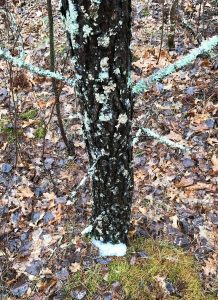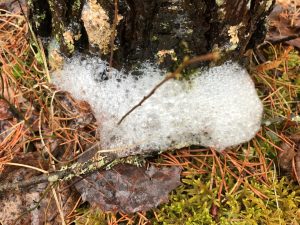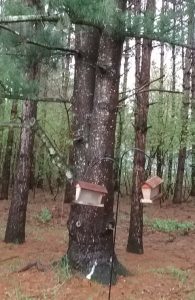Recently, there were two reports of a white, frothy substance on the bases of otherwise healthy- looking, mature pine. There are two different possible explanations for this interesting and unusual phenomenon.

Frothy foam at tree base, from distance. Photo by Gary Vander Wyst.

Frothy foam at tree base, close up. Photo by Gary Vander Wyst.
The first is the formation of a crude soap mixture through “stemflow mixing.” As rainwater trickles down tree stems (called stemflow), it collects dust particles (e.g., salts) and plant residues (e.g., acids) that have accumulated on the bark surfaces. As the downward-flowing solution of dissolved acids and salts encounter bark plates, furrows, and ridges, the solution is agitated and aerated, resulting in the formation of suds which collect diffusely at the tree base. Occasionally a light coating of suds is visible higher on the stem. Stemflow mixing has no known affect on tree health.

Alcoholic flux. Photo by Mark Diesen.
The second possible cause of foam formation is the fermentation of sap by microbes, known as alcoholic flux. When wounds and cracks in the cambial area exude sap, microbes such as yeasts may ferment the sap, producing alcohol and gases. This milky colored, alcoholic froth then exudes from the crack/wound to the bark surface, sometimes forming a bubbly stream that smells of fermentation and persists for only a short time. Alcoholic, frothy flux typically originates at a specific location on the tree and is associated with wounds or cracks that may independently cause strength loss or wood defects.
Written by Paul Cigan, forest health specialist, Hayward (Paul.Cigan@Wisconsin.gov), 715-416-4920.
